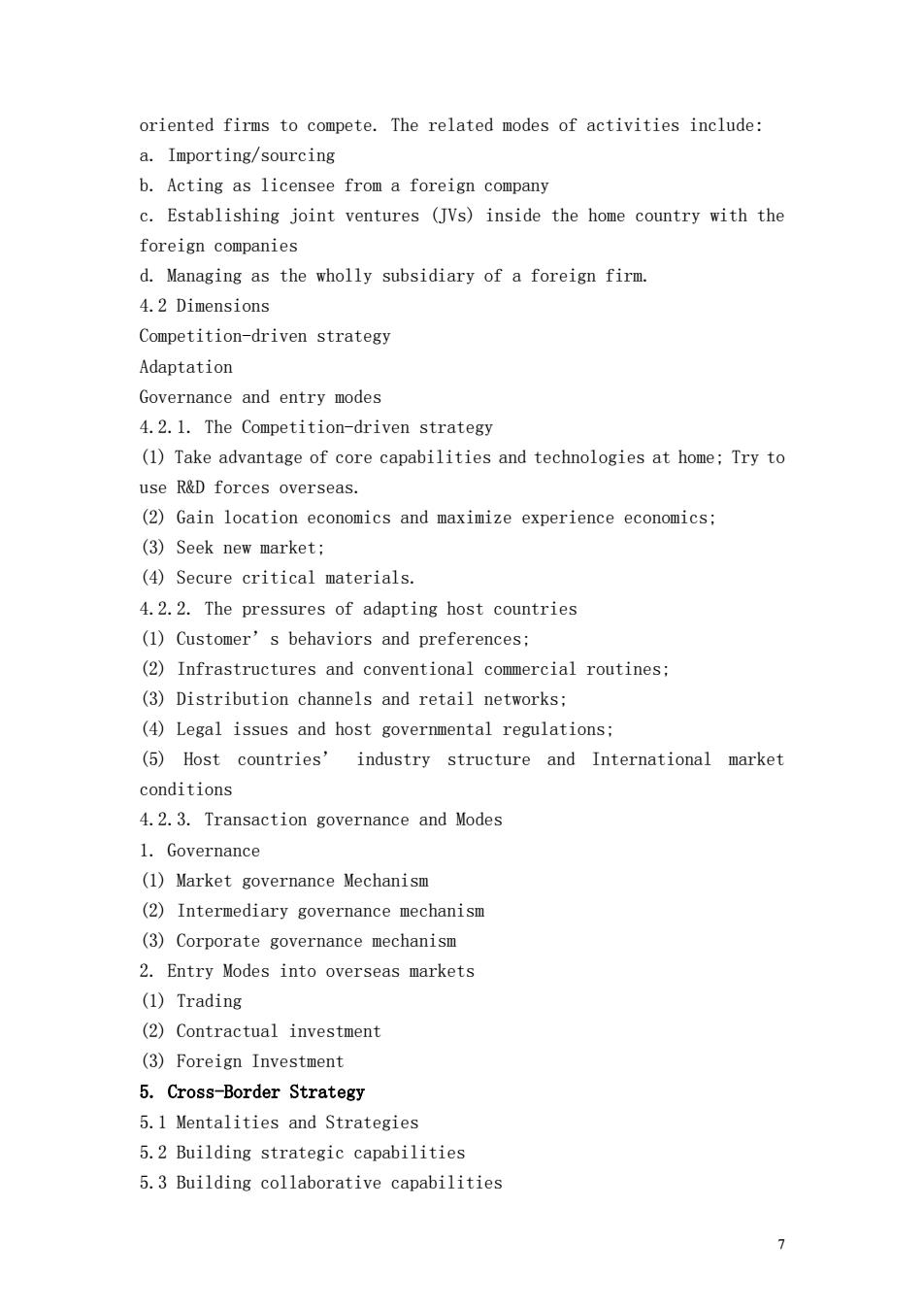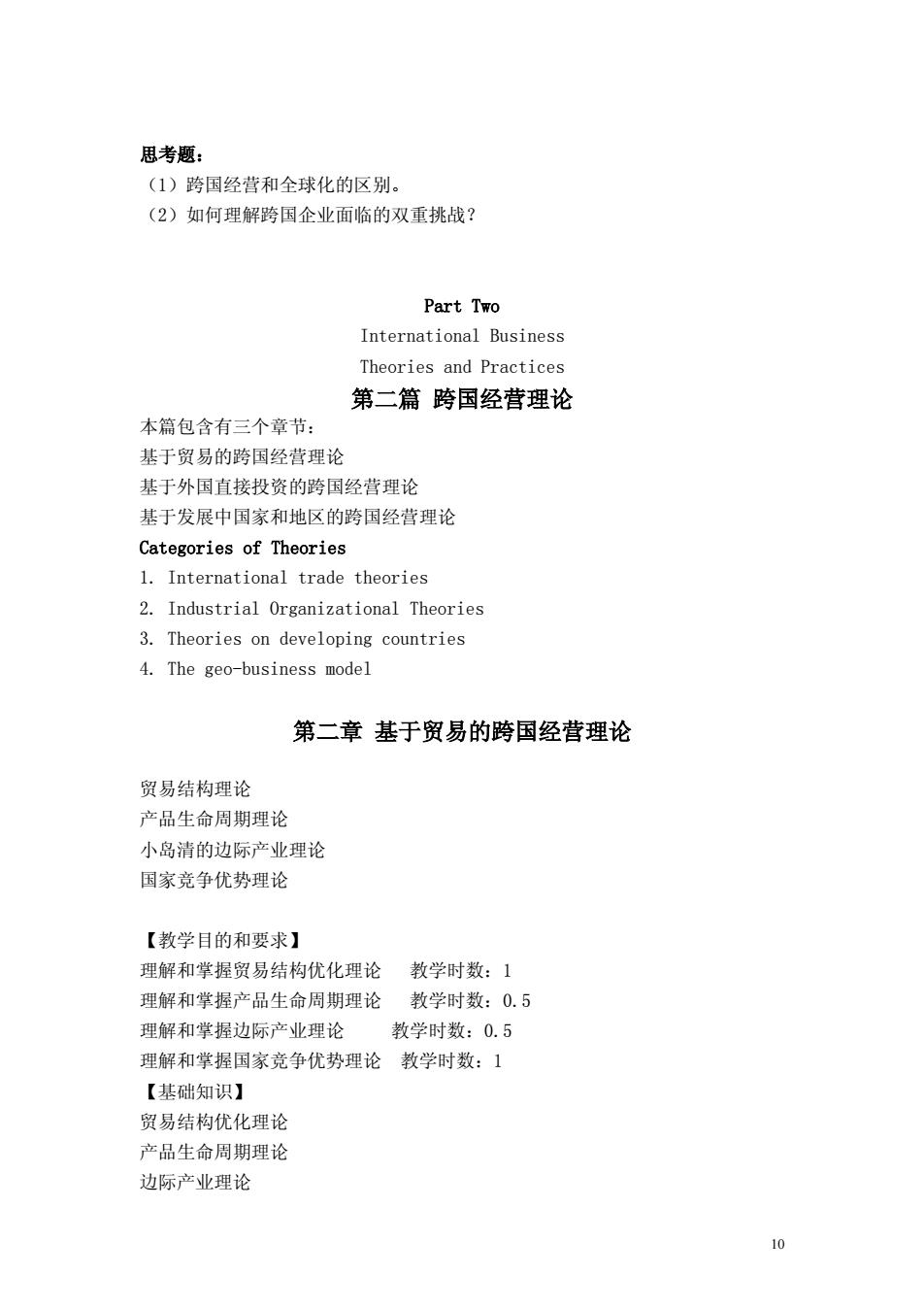
In essence,this definition pays more attention on the importance of strategic and organizational integration and,thereby,management integration of operations located in different countries is regarded as the key differentiating characteristic of an MNC. What really differentiates the MNC is that it creates an internal organization to carry out key cross-border tasks and transactions internally rather than depending on trade through the open markets. 1.Structural Criterion (1)Operations location (2)Value activities'Facilities and relationship (3)Ownership 2.Transnationality 3.Attitude toward international business (ethnocentric,polycentric, and geocentric) 4.Internationalization Internationalization is the process by which firms increase their awareness of the influence of international activities on their future, and establish and conduct transactions with firms from other countries. 4.1 Perspective:Out-war In-ward-Looking Internationalization has both inward looking and outward looking dimension. The outward-looking perspective incorporates an awareness of the nature of competition in foreign markets,and includes the following modes of activities: a.Exporting B.Acting as licensor to a foreign company c.Establishing joint ventures outside the home country with foreign companies d.Establishing or acquiring wholly-owned businesses outside the home country Internationalization affects firms in equal important ways from an inward-looking perspective,which incorporates an awareness of the impact of Multinational Corporations (MNCs)on the ability of domestically 6
6 In essence, this definition pays more attention on the importance of strategic and organizational integration and, thereby, management integration of operations located in different countries is regarded as the key differentiating characteristic of an MNC. What really differentiates the MNC is that it creates an internal organization to carry out key cross-border tasks and transactions internally rather than depending on trade through the open markets. 1. Structural Criterion (1) Operations location (2) Value activities’ Facilities and relationship (3) Ownership 2. Transnationality 3. Attitude toward international business (ethnocentric, polycentric, and geocentric) 4. Internationalization Internationalization is the process by which firms increase their awareness of the influence of international activities on their future, and establish and conduct transactions with firms from other countries. 4.1 Perspective: Out-war & In-ward-Looking Internationalization has both inward looking and outward looking dimension. The outward-looking perspective incorporates an awareness of the nature of competition in foreign markets, and includes the following modes of activities: a. Exporting B. Acting as licensor to a foreign company c. Establishing joint ventures outside the home country with foreign companies d. Establishing or acquiring wholly-owned businesses outside the home country Internationalization affects firms in equal important ways from an inward-looking perspective, which incorporates an awareness of the impact of Multinational Corporations (MNCs) on the ability of domestically

oriented firms to compete.The related modes of activities include: a.Importing/sourcing b.Acting as licensee from a foreign company c.Establishing joint ventures (JVs)inside the home country with the foreign companies d.Managing as the wholly subsidiary of a foreign firm. 4.2 Dimensions Competition-driven strategy Adaptation Governance and entry modes 4.2.1.The Competition-driven strategy (1)Take advantage of core capabilities and technologies at home;Try to use R&D forces overseas. (2)Gain location economics and maximize experience economics: (3)Seek new market; (4)Secure critical materials. 4.2.2.The pressures of adapting host countries (1)Customer's behaviors and preferences; (2)Infrastructures and conventional commercial routines: (3)Distribution channels and retail networks; (4)Legal issues and host governmental regulations; (5)Host countries'industry structure and International market conditions 4.2.3.Transaction governance and Modes 1.Governance (1)Market governance Mechanism (2)Intermediary governance mechanism (3)Corporate governance mechanism 2.Entry Modes into overseas markets (1)Trading (2)Contractual investment (3)Foreign Investment 5.Cross-Border Strategy 5.1 Mentalities and Strategies 5.2 Building strategic capabilities 5.3 Building collaborative capabilities
7 oriented firms to compete. The related modes of activities include: a. Importing/sourcing b. Acting as licensee from a foreign company c. Establishing joint ventures (JVs) inside the home country with the foreign companies d. Managing as the wholly subsidiary of a foreign firm. 4.2 Dimensions Competition-driven strategy Adaptation Governance and entry modes 4.2.1. The Competition-driven strategy (1) Take advantage of core capabilities and technologies at home; Try to use R&D forces overseas. (2) Gain location economics and maximize experience economics; (3) Seek new market; (4) Secure critical materials. 4.2.2. The pressures of adapting host countries (1) Customer’s behaviors and preferences; (2) Infrastructures and conventional commercial routines; (3) Distribution channels and retail networks; (4) Legal issues and host governmental regulations; (5) Host countries’ industry structure and International market conditions 4.2.3. Transaction governance and Modes 1. Governance (1) Market governance Mechanism (2) Intermediary governance mechanism (3) Corporate governance mechanism 2. Entry Modes into overseas markets (1) Trading (2) Contractual investment (3) Foreign Investment 5. Cross-Border Strategy 5.1 Mentalities and Strategies 5.2 Building strategic capabilities 5.3 Building collaborative capabilities

5.4 Developing coordination and control 5.5 Creating and leveraging world-wide knowledge 5.1 Mentalities and strategies International strategy Multinational strategy Global strategy Transnational strategy 5.2 Building strategic capabilities 1.Goals 2.Means 5.3 Building collaborative capabilities 1.Why strategic alliances? 2.The risks and costs of Collaboration 3.Building and managing collaborative ventures 5.4 Developing coordination and control 1.Administrative heritage (1)Decentralized federation (2)Coordinated federation (3)Centralized hub 2.Anatomy,Physiology,and Psychology (1)Structuring the orga.'s anatomy (2)Building the org.'s physiology (3)Developing the org.'s Psychology 3.Managing the change process 5.5 Creating and leveraging world-wide knowledge Building multiple innovative processes: 1.Making central innovations effective 2.Making local innovation efficient 3.Making transnational process feasible
8 5.4 Developing coordination and control 5.5 Creating and leveraging world-wide knowledge 5.1 Mentalities and strategies International strategy Multinational strategy Global strategy Transnational strategy 5.2 Building strategic capabilities 1. Goals 2. Means 5.3 Building collaborative capabilities 1. Why strategic alliances? 2. The risks and costs of Collaboration 3. Building and managing collaborative ventures 5.4 Developing coordination and control 1. Administrative heritage (1) Decentralized federation (2) Coordinated federation (3) Centralized hub 2. Anatomy, Physiology, and Psychology (1) Structuring the orga.’s anatomy (2) Building the org.’s physiology (3) Developing the org.’s Psychology 3. Managing the change process 5.5 Creating and leveraging world-wide knowledge Building multiple innovative processes: 1. Making central innovations effective 2. Making local innovation efficient 3. Making transnational process feasible

第二节全球化挑战 全球化的内涵 全球统一市场 全球市场新规则 FDI特征 中国外贸和利用外资 中国进出口贸易总额:(亿美元) 我国实际使用外国直接投资情况汇总表 第三节跨国经营与跨国企业所面临的挑战 传统的补救措施与新问题(0ld remedies and new problems) 全球竞争的不连续性(Competitive discontinuity)对跨国公司的挑战 跨国公司面临的内部挑战:转变内部治理方式(Transforming Internal Governance) 竞争的不连续性(Competitive discontinuity) 1.消费市场发生重大变化(Prosumerism) 2.行业自由化、私有化和全球化(Deregulation,privatization,and globalization) 3.中间环节在消失(Disintermediation) 4.技术进步与数字化(Digital convergence) 不确定的竞争局面(Indeterminate competitive landscape) 6.激烈的标准竞争和日趋标准公开(Evolution to open standards) 7.产品生命周期越来越短 8.生态与社会的敏感性(Ecological and social sensibility) 转变内部治理方式 (1)更加主动地面向市场竞争 (2)始终关注未来 (3)重视中层管理力量在战略制定中作用 (4)发展战略联盟关系 (5)重视人和事之间的分离性 跨国经营的概念和历史发展 跨国经营的起源(1600-1914) 两次世界大战期间的跨国经营(1914-1945) 第二次世界大战后的跨国经营(1945-1980) 20世纪80年代后的跨国经营(1980至今)
9 第二节 全球化挑战 全球化的内涵 全球统一市场 全球市场新规则 FDI 特征 中国外贸和利用外资 中国进出口贸易总额:(亿美元) 我国实际使用外国直接投资情况汇总表 第三节 跨国经营与 跨国企业所面临的挑战 传统的补救措施与新问题 (Old remedies and new problems) 全球竞争的不连续性(Competitive discontinuity)对跨国公司的挑战 跨国公司面临的内部挑战:转变内部治理方式(Transforming Internal Governance) 竞争的不连续性(Competitive discontinuity) 1.消费市场发生重大变化(Prosumerism) 2 . 行 业 自 由 化 、 私 有 化 和 全 球 化 ( Deregulation, privatization, and globalization) 3.中间环节在消失(Disintermediation) 4.技术进步与数字化(Digital convergence) 不确定的竞争局面(Indeterminate competitive landscape) 6.激烈的标准竞争和日趋标准公开(Evolution to open standards) 7.产品生命周期越来越短 8.生态与社会的敏感性(Ecological and social sensibility) 转变内部治理方式 (1)更加主动地面向市场竞争 (2)始终关注未来 (3)重视中层管理力量在战略制定中作用 (4)发展战略联盟关系 (5)重视人和事之间的分离性 跨国经营的概念和历史发展 跨国经营的起源(1600-1914) 两次世界大战期间的跨国经营(1914-1945) 第二次世界大战后的跨国经营(1945-1980) 20 世纪 80 年代后的跨国经营(1980 至今)

思考题: (1)跨国经营和全球化的区别。 (2)如何理解跨国企业面临的双重挑战? Part Two International Business Theories and Practices 第二篇跨国经营理论 本篇包含有三个章节: 基于贸易的跨国经营理论 基于外国直接投资的跨国经营理论 基于发展中国家和地区的跨国经营理论 Categories of Theories 1.International trade theories 2.Industrial Organizational Theories 3.Theories on developing countries 4.The geo-business model 第二章基于贸易的跨国经营理论 贸易结构理论 产品生命周期理论 小岛清的边际产业理论 国家竞争优势理论 【教学目的和要求】 理解和掌握贸易结构优化理论 教学时数:1 理解和掌握产品生命周期理论 教学时数:0.5 理解和掌握边际产业理论 教学时数:0.5 理解和掌握国家竞争优势理论教学时数:1 【基础知识】 贸易结构优化理论 产品生命周期理论 边际产业理论 10
10 思考题: (1)跨国经营和全球化的区别。 (2)如何理解跨国企业面临的双重挑战? Part Two International Business Theories and Practices 第二篇 跨国经营理论 本篇包含有三个章节: 基于贸易的跨国经营理论 基于外国直接投资的跨国经营理论 基于发展中国家和地区的跨国经营理论 Categories of Theories 1. International trade theories 2. Industrial Organizational Theories 3. Theories on developing countries 4. The geo-business model 第二章 基于贸易的跨国经营理论 贸易结构理论 产品生命周期理论 小岛清的边际产业理论 国家竞争优势理论 【教学目的和要求】 理解和掌握贸易结构优化理论 教学时数:1 理解和掌握产品生命周期理论 教学时数:0.5 理解和掌握边际产业理论 教学时数:0.5 理解和掌握国家竞争优势理论 教学时数:1 【基础知识】 贸易结构优化理论 产品生命周期理论 边际产业理论